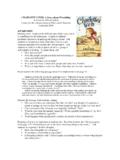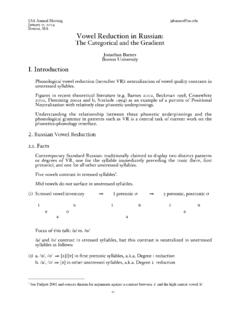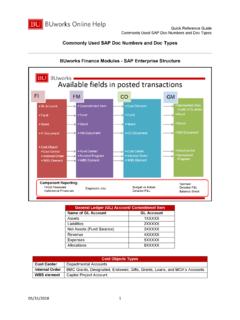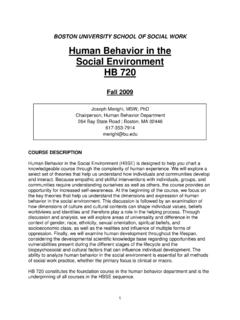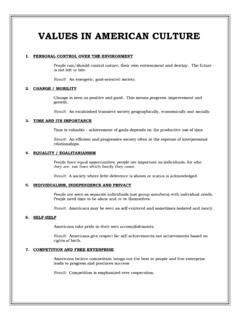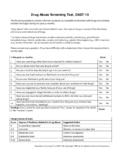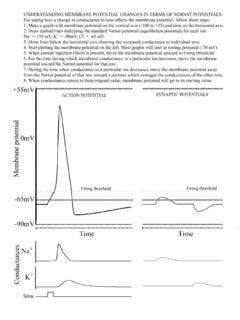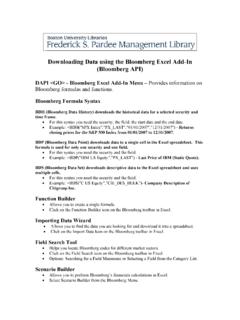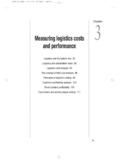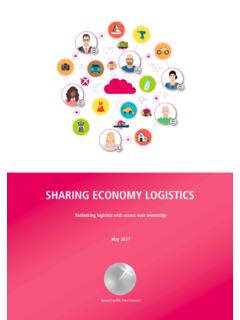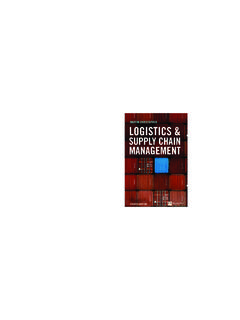Transcription of TRANSPORTATION LOGISTICS IN GLOBAL VALUE AND …
1 1 TRANSPORTATION LOGISTICS IN GLOBAL VALUEAND SUPPLY CHAINSLata ChatterjeeChiung-min TsaiCenter for TRANSPORTATION StudiesBoston University2 TABLE OF CONTENTS1. LOGISTICS IN THE INTERNATINAL INTEGRATION OF TRANSPORTATION LOGISTICS IN INTEGRATED LOGISTICS TRANSPORTATION LOGISTICS : Objectives and Third Party Other SPATIAL IMPACTS OF TRANSPORTATION CONCLUDING INTRODUCTIONG lobalization represents the cross-national functional integration and coordination ofspatially dispersed economic activities. As globalization is becoming the norm in an increasingrange of economic sectors, the resulting worldwide coordination of production and supplyemerges as a complex harmonization process -- across differing cultures, various economicsystems, shifting government regulations, and a host of international rules and is fundamentally changing the environment of business decisions have to be increasingly taken in the new context where business operationsare subject to worldwide forces of fierce competition.
2 Firms have to respond strategically inorder to stay competitive in this arena. Firms have typically two sources for gaining a strategy-driven competitive edge: a) the continuous creation of new products and incorporation of newtechnologies, and b) the firm s decisions on the rationalization of existing operations. The latterdevice of rationalization involves, among other actions, the streamlining of production processesand broadening of the sourcing of raw materials and intermediate goods to a GLOBAL market. Inorder to reduce overall costs and produce significant profits, the best practice firms are bothsourcing and marketing in an increasingly interdependent international market.
3 While GLOBAL sourcing responds to the needs of manufacturing and service enterprises forcheaper materials and components, the resultant cost savings can be realized only if there areefficient logistical services which permit efficient GLOBAL sourcing. According to theInternational Institute for Management and Development (IMD) LOGISTICS refers to the movementand storage of goods intermediate and final associated with the information flows from thebeginning to the end of the supply chain (IMD 1993). While there are many elements in efficient4logistics--for example, the capture, storage and retrieval of information on goods, materialsmanagement, design of manufacturing strategies and the like -- a reliable, cost effectivetransportation system is fundamental to the integrated LOGISTICS are innovative ways in which firms are combining TRANSPORTATION and distributionsystems to increase their efficiencies in the globally competitive environment.
4 Though thetransportation LOGISTICS systems vary with type of product and geographical scope of the marketfor raw materials, components and finished products, there is a common objective underlying thevarious strategies. The common objective is to get the right product to the right place at the righttime so the cost of holding inventory is minimized. In 1998, more than 60% of production andsales were processed from direct orders rather than from stock (Gwilliam, 1998). The CatoInstitute showed that carrying and holding costs represented 25-30% of the VALUE of inventoriesin firms due to product, depreciation and interest (IMD, 1993).
5 Inventory reduction hasbecome of paramount importance for the firm, and has become feasible due to changes inproduction technology--with use of computer controlled manufacturing, robotics and other usesof information technology for cost effective smaller production runs. LOGISTICS for effectiveinventory management is a key to this new geography of production as component productionfacilities are distributed in a number of countries and regions within a is increasing in importance as restructuring of firms often entails relying onexternal vendors - an attribute of Just in Time production systems.
6 Considerable researchattention has been devoted in recent years to Just in Time or lean production systems, as well asto flexible specialization in production, which has emerged in the context of rising wages inadvanced economies and overall excess capacity relative to demand (Piore & Sabel, 1984;Storper & Scott, 1992). The flexible specialization theory maintains that manufacturing5production chains are switching from vertical integration, representative of the mass or Fordistproduction systems, to fragmented and vertically disintegrated forms. Consequently, theadvantages of scale economies in mass production are being replaced by economies derived fromhorizontal, globally based input-output linkages (Markusen, 1996).
7 A discussion of thedifference between mass production and lean production from an from an engineeringperspective can be found in Preiss (1997). A variety of organizational, and geographicarrangements have emerged, in practice, to capture the upstream and downstream advantages ofsuch globally based material-component-output linkages. Efficient and reliable transportationand distribution are crucial for inventory management in such GLOBAL production reliable delivery of input materials and component parts to manufacturing centers andof delivery of product to markets have become crucial, the pressures for cost minimization aretransforming TRANSPORTATION , storage and handling practices.
8 Moreover, the increasing trend inintra-firm trade, resulting from intra-firm division of labor on a GLOBAL basis, is also dependent onreliable delivery schedules. Thus, cost reductions through GLOBAL sourcing need to be supportedby systems ensuring reliable delivery from spatially far-flung suppliers and vendors. Costadvantages are quickly eroded if subcontractors and component suppliers fail to deliver on failures can arise if part of the GLOBAL production chain is located in low wage countries,where barriers to cross-border transit abound and create poor logistical practices.
9 In suchsituations control over spatially disaggregated delivery schedules becomes problematic and thesmooth operation of the production system is threatened. Logistical innovations are emerging toaddress such challenges. Improvements in TRANSPORTATION LOGISTICS , associated with supply chainmanagement, represents one component of the state-of-the-art logistical paper on transport LOGISTICS attempts to systematize the links between transportationlogistics and supply chain operations. It identifies the elements of these processes and drawsattention to significant factors and variables governing these processes.
10 As transportationlogistics is in its formative and dynamic stage, we have considerable information on the practicesof firms, most of which are "learning by doing". Our knowledge of TRANSPORTATION LOGISTICS isthus rich in case experience and limited in standardized information. The role of LOGISTICS inglobalization is discussed in Section 2. The characteristics of TRANSPORTATION LOGISTICS arediscussed in section 3. The spatial consequences are explored in Section 4. The paper concludesby highlighting some potential trends and emphasizes data LOGISTICS IN THE INTERNATINAL INTEGRATION OFECONOMIESTwo of the primary drivers of globalization in recent times have been: a) the lowering oftariff and non-tariff barriers to trade, and b) the sharp decline in TRANSPORTATION andcommunication costs.
